- Published: Monday, November 02 2015 18:36
Introduction
Singapore, 1999. I was lying on the grass, looking up into the night sky. A few of my friends and I had gathered on the lawn of an abandoned building overlooking the Singapore Strait to watch the Leonids which, according to the newspaper, were going to be spectacular that year. We sipped wine out of plastic cups, listened to the macaques play in the Banyan trees, and soaked in the balmy, humid night air. None of us had any idea about astronomy. I had bought a copy of Nightwatch by Terence Dickinson and was leafing through the star maps at the back of the book, trying to figure out where Leo was, and failing miserably. But no matter - we were all there for the experience. As the evening advanced and the cosmic light show began, the group fell silent except for the intermittent "There! I saw one!" Gazing into the stars, a deep, joyous calm came over me. It felt like coming home. I'd always had an interest in astronomy, but never really done anything about it. After all, I'm an artist. What do I know from science? But that evening I decided to do something about it. I decided to buy a telescope.
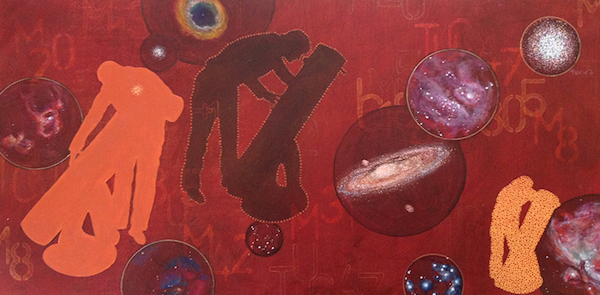
Deep Sky, 2013
acrylic on birch
6" x 12"
The purchase of my first telescope, a Meade ETX 90, was the start of my life-long love affair with astronomy. Soon after I bought my little Meade I joined the Astronomical Society of Singapore (TASOS), started reading astronomy textbooks, and spent my disposable income on Moon filters and eye pieces.
My passion for astronomy also began to colour my artistic practice. I was studying at the Nanyang Academy of Fine Arts in Singapore at the time, and for my degree show project I painted a series of large light-boxes with supernova remnants and set up a sound-and-light installation called Cosmic Breath. It was a big hit, and launched my path into the field of astronomical art.

Visual Voice Gallery
2015
exhibition: The Dopamine Collective
photo: Sean Stewart
My globe-trotting has now brought me to Montreal, Canada. Here I run Visual Voice Gallery, an art gallery which specializes on exhibiting contemporary art which creates a dialogue with science (more about that in an upcoming blog post). Between organizing art shows and gallery openings I still manage (somehow) to maintain my artistic practice. Over the next few weeks I will share with you four astronomy-informed art projects. I would take this moment to thank Astronomers Without Borders for inviting me to contribute to their fantastic blog, and for the outstanding work they do in bringing astronomy to a wider audience. It is a great honor to be part of this exceptional group of astronomers and artists.
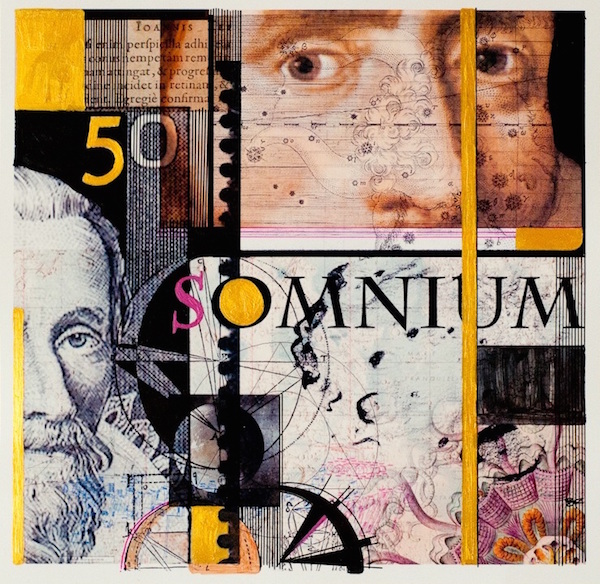
Kepler (Somnium Series)
2013
digital print, acrylic, ink on paper
8.25" x 8.25"
The Somnium Series
(2009 - 2013)
Who wrote the first fiction book? Is it Isaac Asimov? H. G. Wells? Jules Verne?
Actually, the first ever science fiction book is titled Somnium (The Dream) and was written 400 years ago by the German astronomer Johannes Kepler. It describes a fantastic voyage to the Moon, its inhabitants, its landscape, and the solar system’s celestial motion. The Somnium is loosely based on Kepler's student thesis, written in 1593, though he never actually submitted the paper. His thesis described the motion of the planets as seen from the surface of the Moon, serving as an illustration of the Copernican heliocentric model of the solar system. At the time this was a dangerous position to take, and in an effort to escape religious persecution (and dismissal from Tübingen University) Kepler rewrote his paper as a fiction. Over the course of his lifetime Kepler added about 100 pages of footnotes to the 22-page document, adding the new ideas and insights he gained while researching his laws of planetary motion. He died before he could see his book in printed form; it was his son, and eventually his son-in-law, who published the work in 1634. The Somnium has never been illustrated, so I decided to develop a series of artworks inspired by this text, to increase awareness about this under-appreciated but significant book.
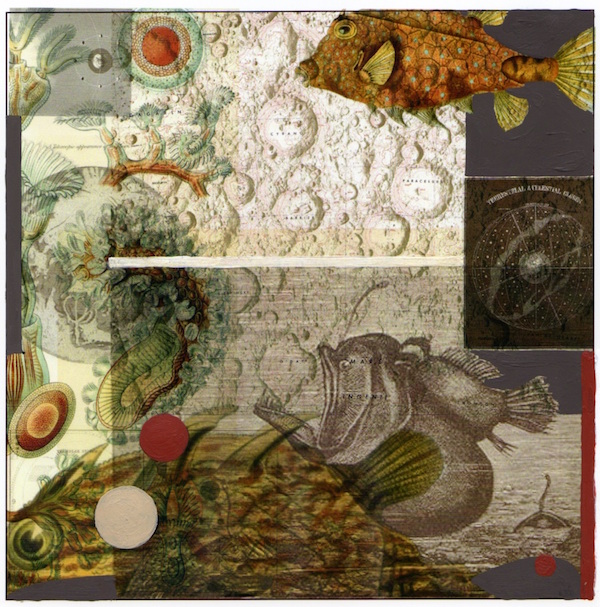
Moonfish (Somnium Series)
2009
digital print, acrylic, ink on paper
8.25" x 8.25"
First stop: visual research. I began with a complete immersion into the book, reading editions of the text in German and in English, and researching the life and work of Johannes Kepler, as well as astronomy of the 17th century. Any project should have a solid conceptual basis, and research really helps me to frame my ideas. My next step was to set up a databank of images which reflect the key elements of the storyline.
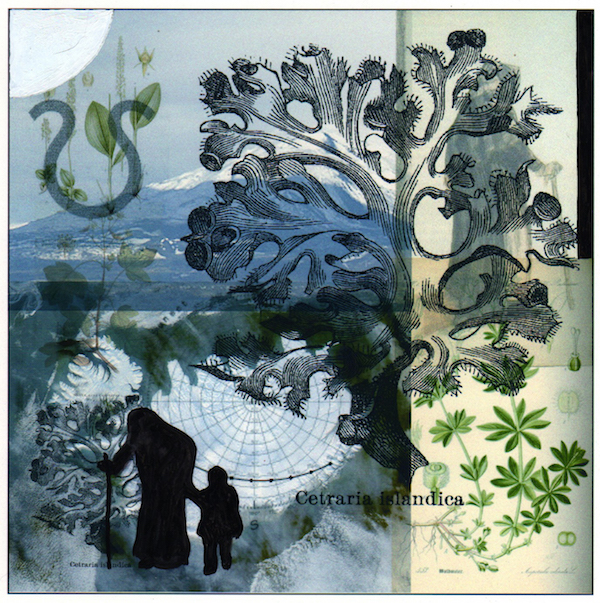
Mount Hekla (Somnium Series)
2009
digital print, acrylic, ink on paper
8.25" x 8.25"
I then randomly printed these images on top of each other with an inkjet printer, creating accidental, dreamlike compositions. As a final step I blocked out and over-painted chosen areas of the prints with inks and acrylic paints, pulling the composition together. Each print is a unique artwork, sitting on the cusp of chaos and control. These prints then served as jumping off-points for large-format paintings.

Levania / Eclipse (Somnium Series)
2009
digital print, acrylic, ink on paper
8.25" x 8.25"

Tycho Brahe (Somnium Series)
2009
digital print, acrylic, ink on paper
8.25" x 8.25"
But the most fun I had with the Somnium images was during a Shopdropping project. Shopdropping is basically reverse shoplifting: you buy and item, artistically modify it, and then sneak it back into the store where you bought it. It is also important to document your shopdrop by surreptitiously taking photos of your installation. Montreal artists Natalie Reis and Vanda Daftari invited me to participate in the Shopdropping project at the 2009 Montreal Biennale. I executed Shopdrops in four different Montreal supermarkets, as well as one in Hamburg, Germany. The artworks I 'dropped' were cans of beans where I had replaced the labels with my own prints. The new labels told the story of the Somnium and featured some of my Somnium Series images. For one shopdrop I also slid long paper strips with a Somnium-inspired poem into the plastic covering fronting each shelf (where you would usually find the prices) to create a life-sized poem.

Shopdropping (Provigo, Montreal)
2009
photographic documentation
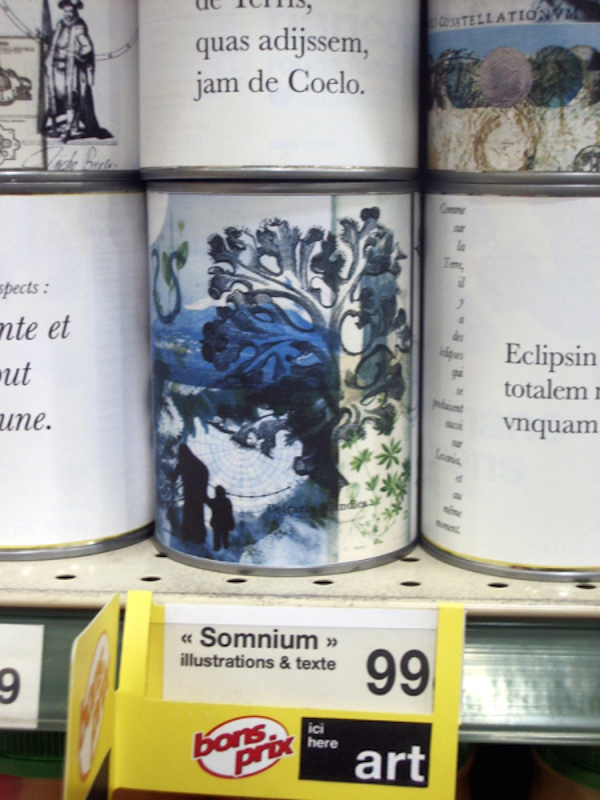
Shopdropping (Provigo, Montreal)
2009
photographic documentation
It is surreal to see your artworks on supermarket shelves, but that is also part of the guerilla-art aspect of the shopdropping concept: by inserting art in a public space shopdroppers create access to art for an audience that may not usually visit art galleries. And it allows artists to circumvent the art gallery infrastructure, allowing them to introduce their art directly to the public.
If you are interested to further explore some of the ideas mentioned above, I suggest these further readings:
Kepler's Somnium: The Dream, or Posthumous Work on Lunar Astronomy
translation by Edward Rosen
http://www.amazon.com/Keplers-Somnium-Dream-Posthumous-Astronomy/dp/0486432823/ref=sr_1_3?ie=UTF8&qid=1446393616&sr=8-3&keywords=somnium+kepler
Johannes Kepler Life and Letters
Carola Baumgardt
http://www.amazon.com/Johannes-Kepler-Letters-Carola-Baumgardt/dp/0806530960/ref=sr_1_1?s=books&ie=UTF8&qid=1446393791&sr=1-1&keywords=kepler+life+and+letters
Read more about the shopdropping:
http://shopdropping.net
Read more about shopdropping at the Montreal Biennale
http://shopdroppingmontreal.blogspot.ca
Nanyang Academy of Fine Arts
http://www.nafa.edu.sg
The Astronomical Society of Singapore (TASOS)
http://tasos.org.sg








corinne cowan